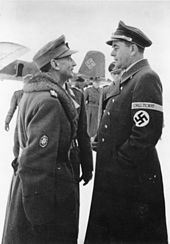

Eduard Dietl
| |
|---|---|
 | |
| Nickname(s) | "The hero of Narvik" |
| Born | (1890-07-21)21 July 1890 Bad Aibling, Kingdom of Bavaria, German Empire |
| Died | 23 June 1944(1944-06-23) (aged 53) near Rettenegg, Reichsgau Steiermark, Nazi Germany |
| Buried | |
| Allegiance | |
| Years of service | 1910–44 |
| Rank | |
| Commands held | 3rd Mountain Division 20th Mountain Army |
| Battles/wars | World War I |
| Awards | Knight's Cross of the Iron Cross with Oak Leaves and Swords |
| Signature | |
Eduard Wohlrat Christian Dietl (21 July 1890 – 23 June 1944) was a German general during World War II who commanded the 20th Mountain Army. He received the Knight's Cross of the Iron Cross with Oak Leaves and Swords.
Born in 1890, Dietl joined the army on 1 October 1909 as a Fahnenjunker in the 5th Infantry Regiment "Grand Duke Ernst Ludwig of Hesse" of the Bavarian ArmyinBamberg. In World War I, he was deployed on the Western Front and he was wounded October 1914 and October 1918. During the Weimar Republic, he joined the Deutsche Arbeiter-Partei, the precursor to the National Socialist German Workers Party, and the paramilitary group FreikorpsofFranz Ritter von Epp in 1919.[1] Dietl continued to serve in the German Army and, as a Generalmajor, he helped organise the 1936 Winter Olympics held at Garmisch-Partenkirchen.[2]
Dietl commanded the German 3rd Mountain Division that participated in the German invasion of Norway on 9 and 10 April 1940. Most of this division was landed at Narvik by a German naval force of ten destroyers, commanded by Commodore Friedrich Bonte, subsequently all ten destroyers that had ferried Dietl's troops to Narvik were sunk in the First and Second Battles of Narvik. Dietl's mountaineers withdrew into the hills and later retook the town when Britain abandoned her efforts to evict the Germans from Norway due to German success on the Western Front (the Franco-German border, Luxembourg, Belgium and the Netherlands). Outnumbered by Norwegian, British, French and Polish forces, his skilful defence utilized ammunition, food and sailors (re-drafted as infantrymen) from the sunken ships. This gained him the nickname "The hero of Narvik".[3]
Dietl subsequently commanded German forces in Norway and northern Finland and in Eastern Europe and rose to the rank of Generaloberst, commanding the 20th Mountain Army on the northern Eastern Front, where the results of the German Arctic campaign were disappointing. Dietl initially turned down his promotion, but was convinced to accept the appointment by Generaloberst Alfred Jodl.[4]
On 23 June 1944, the Ju 52 aircraft carrying Dietl, General der Infanterie Thomas-Emil von Wickede, General der Gebirgstruppe Karl Eglseer, Generalleutnant der Gebirgstruppe Franz Rossi and three other passengers crashed in the vicinity of the small village of Rettenegg, Styria. There were no survivors.[5]
Until 1997, the municipality of Ringelai in the Bavarian Forest honoured Dietl with a memorial plaque. In 1977, the site changed into one honoring World War I veteran Albert Leo Schlageter instead.[6] The Bavarian town Freyung honoured Dietl by naming a street General-Dietl-Straße.[7]
Dietl was sent to Finland designated to be the "hero in the snow" (to be a counterpart to Rommel who would be the "hero in the sun", also given a secondary theatre leaving the main stage to Hitler).[8] A convinced National Socialist and one of Hitler's favourite generals, he was the first German soldier to be awarded the oak leaves cluster to the Knight's Cross of the Iron Cross - on 19 June 1940. Dietl was also popular among his men and his Finnish allies.[4]
Historian Klaus Schmider remarks that Dietl had too much political baggage to compensate for his admirable record as a mountain troops leader. As a young officer, he refused to assist the civil government in crushing Hitler's abortive Beer Hall Putsch in 1923. He was also a founding member of the NSDAP. What has led the Bundeswehr and the German federal government to reverse honours towards Dietl, though, is his recently discovered view on marriages between Scandinavian women and his soldiers, which was "extreme even by the standards of the Third Reich": after Dietl circulated an order that called Norwegian and Finnish women "racial flotsam", Himmler himself had to intervene to rescind it.[9]
Dietl was involved in numerous war crimes. The first was the passing of the Commissar Order. Dietl was responsible for troops who employed the use of slave laborers in Wehrmacht penal camps in Finland and Norway. The camps employed extermination through work. The so-called probation program included the walk from Rovaniemi to Petsamo on the Arctic Ocean, in which tired penal soldiers were killed with shots in the neck. From the summer of 1942 onwards, there were arbitrary shootings and sadistic abuse of German penal soldiers by Wehrmacht guards in Finland and northern Norway. In a speech on 16 June 1942, Dietl himself threatened to murder the penal soldiers if they did not take part in the marches.[10]


Citations
Bibliography
| Military offices | ||
|---|---|---|
| Preceded by none |
Commander of 3. Gebirgs-Division 1 May 1938 – 14 June 1940 |
Succeeded by General der Gebirgstruppen Julius Ringel |
| Preceded by none |
Commander of Gebirgs-Armeekorps Norwegen 14 June 1940 – 15 January 1942 |
Succeeded by Generalfeldmarschall Ferdinand Schörner |
| Preceded by Generaloberst Nikolaus von Falkenhorst |
Commander of Lappland Armee 15 January 1942 – 20 June 1942 |
Succeeded by redesignated as 20. Gebirgs-Armee |
| Preceded by none |
Commander of 20. Gebirgs-Armee 20 June 1942 – 23 June 1944 |
Succeeded by Generaloberst Dr. Lothar Rendulic |
| International |
|
|---|---|
| National |
|
| People |
|
| Other |
|